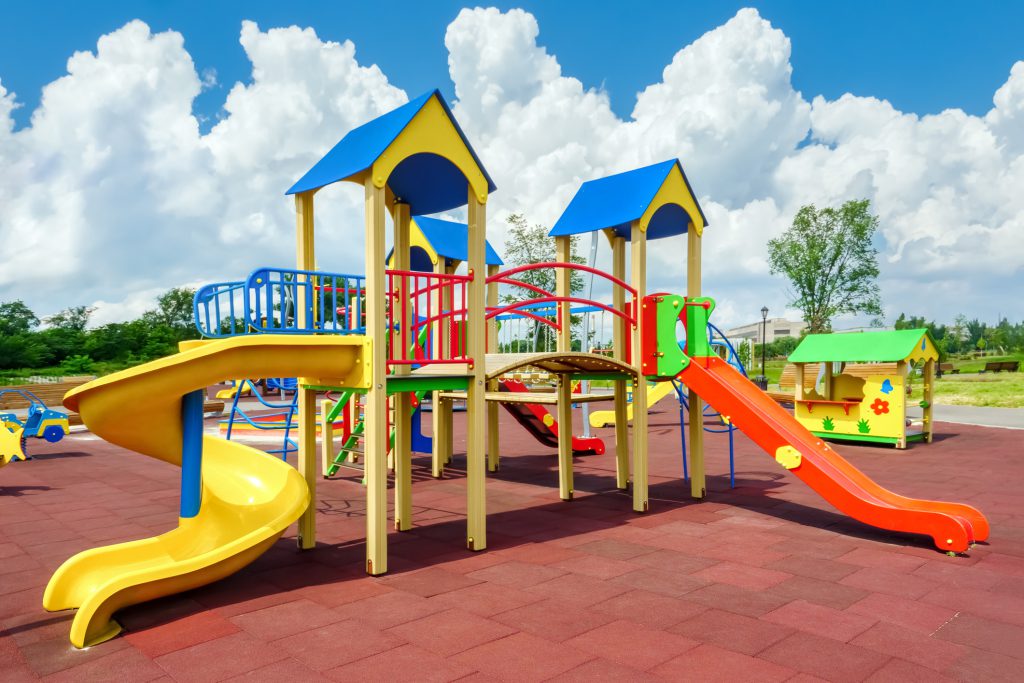Manufacturing Monday Blog Series: Playground Equipment
Posted on byThe blog content comes from the NIOSH Manufacturing Monday seminar series.

With spring in full swing many of us will be heading outdoors more. For those of us with children, that could mean a trip to the playground on a nice day. National Playground Safety Week is April 25th through April 29th and reminds us of the importance of outdoor play and playground safety.
The first playgrounds originated in Germany as “sand gardens” during the latter part of the 19th century, with the beginning of playgrounds appearing in the U.S. around the same time. Playgrounds were originally presented as a safe place for children to learn to play together, as opposed to the busy streets that many children were exposed to in urban environments. One of the first official playgrounds in the country was built at Golden Gate Park in San Francisco. It included swings, a slide, and even a carousel, which was considered an oddity when it was opened in 1887.
Early playgrounds were constructed using galvanized steel pipes with vertical and horizontal supports, ladders, and chains. By today’s standards some of these elements would be considered dangerous. Who remembers spinning way too fast on a playground merry-go-round as a kid? As they aged, playground components were replaced by newer designs and equipment. Rounded edges, molded plastic, composite supports, and soft ground cover have been incorporated to better engage users and incorporate safety.

Today playgrounds come in many shapes and sizes and are manufactured domestically and internationally. Many different materials can be used to make customized play areas. Playground structures are usually made of pressure-treated wood or plastic-coated metal. High-density polyethylene, or HDPE, is often used to make recreation plastics and can easily be formed into a variety of playground equipment in many different fun colors. Poured-in-Place (PIP), rubber tiles, synthetic grass, bonded rubber, Engineered Wood Fiber (EWF), and rubber mulch are all options used for playground surfaces.
Manufacturing playground equipment involves many different processes with quality control checkpoints to be compliant with safety standards. Metal fabrication is used to bend, roll, press, punch, weld and polish different types of metal into the shapes and designs that form playground structures and components. Plastic machining provides highly accurate and customizable parts that fit together perfectly. Plastic molding, like rotational molding, is used to make larger plastic components like slides and roofs as one piece. Powder coating is often used to create a hard finish on components that is safer and lasts longer than conventional painting applications. Before many playground kits are shipped, components are pre-assembled at the factory.
There are many hazards to consider during the manufacturing of playgrounds. During metal fabrication common risks such as metal fumes, airborne silica, molten metals, chemicals, heat, and falling hazards can be present. Workers are often exposed to chemical fumes during plastic molding and/or thermoforming processes. Occupational injuries could occur as a result of contact with various moving parts of plastics machinery as well as the high voltage and high temperature emitted by the machine. Proper work design, engineering controls, and personal protective equipment can mitigate many of these hazards. Ergonomics can also improve assembly line safety and efficiency by avoiding bad postures through appropriate workstation design.
The next time you are at a park or public space and notice a playground, remember all the safety innovations and modern manufacturing processes that went into it. Maybe even spend a little time on a swing or go down a slide… Wee!
For more information on manufacturing visit the NIOSH Manufacturing webpage.
For further information about playgrounds see: Association of Play Industries, IPEMA, and Playground Professionals
RJ Matetic, MS, PhD, NIOSH Associate Director for Manufacturing
Gary Roth, MS, PhD, NIOSH Manufacturing Sector Program Co-Coordinator
Jenny Topmiller, MS, NIOSH Manufacturing Sector Program Co-Coordinator
Richard Current, PE, NIOSH Manufacturing Sector Program Assistant Coordinator
Adam Smith, PhD, NIOSH Manufacturing Sector Program Assistant Coordinator
The blog content comes from the NIOSH Manufacturing Monday seminar series. The Manufacturing Program uses Mondays to highlight happenings within the program and throughout the world of Manufacturing. Some weeks feature seminars by internal or external speakers while others will share recent news and interesting facts related to the Manufacturing community. Many of these topics will also be highlighted here on the NIOSH Science Blog. To share your ideas for future topics contact us at mnf-program@cdc.gov.
Posted on by

